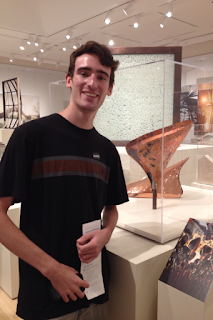The works developed by the Heatherwick Studio proved to be
both fascinating and innovative. Many of the works on display have made it
clear to me the relationship between art and technology. Where technology
blazes the trail of scientific innovation, art inspires and motivates the
scientific community to bring imagination to life in new ways.
One piece that emphasizes that point is the bridge of glass,
pictured in Figure 1. This artistic piece must rely on materials science
engineering, as well as civil engineering in order to be feasible. The brittle
nature of glass makes it an inferior material for use in structures, but the
artists at the Heatherwick studio made their creation possible. In many ways I
am sure the professionals who developed the bridge appreciated the level of detail
and knowledge gained when working with such a brittle building material. There is
no room for error.
Figure 1: Miniature of glass bridge
This imaginative construction is a constant theme throughout
the exhibit. Several structures were on display including designs for parks or
entire communities. These designs usually mimicked nature or had a very natural
element to them. By replicating nature, the buildings break the mold of
traditional structural design. This further pushes structural technology to its
limits. The use of carbon nanotubes or other nanotechnology may allow similar structures
to be built in the future.
The rotating chairs were the most fun and interactive
exhibit. Undoubtedly, much thought was taken into account to design the overall
shape of the piece. The piece strived for rotational symmetry while also
allowing the user the rotate about without falling over. The geometry of the
chair must have been such that it could withstand a significant displacement
from a user without its center of mass from extending past the lower rim. This
design relied heavily on the mathematics of the design, as well as its artistic
value.
Another piece on display that related to material learned in
this class was the handbag made from a single strip of zipper. Fascinating
aspect about these handbags is that the final shape is determined by how the
bag is zipped together. Figure 3 displays an image of the exhibit.
Figure 3: Zipper handbag exhibit
In addition,
I have included a video that allows for the mathematical mechanism of a similar
bag to be more fully understood.
The final piece that I wish to mention also happens to be my
favorite. The Olympic torch for the 2012 games in London symbolized the coming
together of several different entities into one, larger and more powerful
union. This great collective aptly represents the separate nations of our world
joining together in the celebration of competition. This same unity is what
will drive the artistic and scientific communities to achieve new heights.
Figure 4: Me with pieces from the Olympic torch
Figure 5: My ticket for admittance





No comments:
Post a Comment